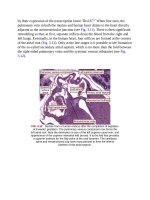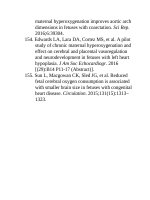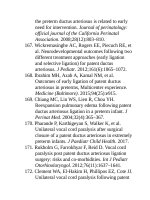Andersons pediatric cardiology 1117
Bạn đang xem bản rút gọn của tài liệu. Xem và tải ngay bản đầy đủ của tài liệu tại đây (123.34 KB, 3 trang )
FIG.42.21 Color-comparisonimageinthesagittalplaneofafetuswith
pulmonarystenosis.Thetwo-dimensionalimageontheleftshowsthe
locationofthepulmonaryvalve.Thecolor-flowDopplerimageontheright
demonstratescorrespondingflowturbulenceoriginatingatthatpoint.
Fetalechocardiographyisindicatedwhencongenitalheartdiseaseis
suspected,which,intheabsenceofotherindications,isoftenfollowingroutine
obstetricultrasoundassessment.Fetalechocardiographyisfrequentlyperformed
between18and22weeksofgestation,butexaminationsaresometimes
performedearlierinselectedhigh-riskcases.Giventhatimageresolutionmay
precludediagnosisorthatcertainlesions(suchaspulmonarystenosis)canbe
subtleand/orprogress,currentrecommendationsaretorepeattheassessmentfor
thoseundergoingfetalechocardiographyinearlygestation.35Fetal
echocardiographyislimitedinpredictingpostnataldiseasedueinparttoboth
postnatalphysiologicchangesandprogressionofdisease.Thereforeanormal
fetalechocardiogramshouldnotprecludepostnatalassessmentwhenthereis
clinicalsuspicionofcongenitalheartdisease.
Atpresentprenataldiagnosisofpulmonarystenosisbyfetalechocardiography
islimitedtoparentalcounselingandmonitoringfortheprogressionofdisease
withserialexaminations.Incaseswheremoderateorseverestenosisis
suspected,admissiontoaneonatalintensivecareunitformonitoringandprompt
cardiologyassessmentshouldbeconsidered.Fetalcardiacinterventionin
pulmonarystenosisisnotcurrentlyroutinelyusedandislimitedtocasesof
pulmonaryatresia/intactventricularseptumwithevolvingrightventricular
hypoplasia.36
MagneticResonanceImagingandComputed
Tomography
Formostpatientswithisolatedpulmonaryvalvestenosis,echocardiographyis
themainimagingtooltoestimatethevalvargradient,andindicationfor
transcathetertherapyisusuallybasedonacombinationofechocardiographic
andclinicaldata.Althoughcross-sectionaltechniques,suchasmagnetic
resonanceangiography(Fig.42.22)orcomputedmultislicespiraltomography,
areconsideredtobelessinvasivethancardiaccatheterization,theseimaging
modalitiesarerarelyneededintheevaluationofsimplepulmonaryvalve
stenosis.Ifthebaselinegradientbyechocardiographysuggeststheneedfor
(transcatheter)intervention,thenaddingcomputedmultislicespiraltomography
priortocardiaccatheterizationwouldexposethepatienttoadditionalradiation
withoutnecessarilyaddingtothemedicaldecisionmakingatthetimeofcardiac
catheterization.Conversely,inapatientwhodoesnotmeetanyindicationfor
valvarinterventionbasedonechocardiographicdata,addingcomputed
tomographyevaluationisunlikelytochangemanagement.
FIG.42.22 Obliquesagittalbalancedsteady-statefreeprecession
magneticresonanceimagesoftherightventricularoutflowtractshowing
stenosisofthepulmonarytrunk.(CourtesyAndrewTaylor,Consultant
CardiacRadiologist,GreatOrmondStreetHospitalforChildren,London.)
Cardiacmagneticresonanceimaging(MRI)andangiographymayhavearole
inselectedpatientsandhasanadvantageovercomputedtomographyevaluation
duetothelackofradiationexposure.Theseimagingmodalitiesmay
complement(notsupplement)standardimaginginselectedpatients,suchas
thosewithsupravalvarpulmonarystenosis.Furthermore,theyoffertheabilityto
notonlyobtainanatomicdimensionsbutalsophysiologicdatasuchasright
ventricularfunctionandvolumes,estimatedgradients,andpulmonary
regurgitantfraction.37,38However,advantagesinsmallchildrenmaystillbe
offsetbytheneedforgeneralanesthesiainsomepatients,eventhoughadvances
haveallowedthetechniquetoexpandtosmallerchildrenwithoutgeneral
anaesthesia.39
Whereascross-sectionaltechniques,particularlythree-dimensional
reconstructions(Fig.42.23),arehelpfulwhenthepulmonarytrunkandits









